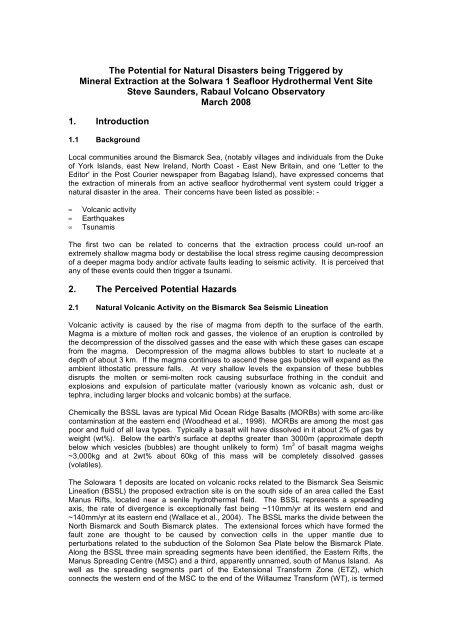Appendices 5-13 - Nautilus Cares - Nautilus Minerals
Appendices 5-13 - Nautilus Cares - Nautilus Minerals
Appendices 5-13 - Nautilus Cares - Nautilus Minerals
Create successful ePaper yourself
Turn your PDF publications into a flip-book with our unique Google optimized e-Paper software.
The Potential for Natural Disasters being Triggered by<br />
Mineral Extraction at the Solwara 1 Seafloor Hydrothermal Vent Site<br />
Steve Saunders, Rabaul Volcano Observatory<br />
March 2008<br />
1. Introduction<br />
1.1 Background<br />
Local communities around the Bismarck Sea, (notably villages and individuals from the Duke<br />
of York Islands, east New Ireland, North Coast - East New Britain, and one 'Letter to the<br />
Editor' in the Post Courier newspaper from Bagabag Island), have expressed concerns that<br />
the extraction of minerals from an active seafloor hydrothermal vent system could trigger a<br />
natural disaster in the area. Their concerns have been listed as possible: -<br />
• Volcanic activity<br />
• Earthquakes<br />
• Tsunamis<br />
The first two can be related to concerns that the extraction process could un-roof an<br />
extremely shallow magma body or destabilise the local stress regime causing decompression<br />
of a deeper magma body and/or activate faults leading to seismic activity. It is perceived that<br />
any of these events could then trigger a tsunami.<br />
2. The Perceived Potential Hazards<br />
2.1 Natural Volcanic Activity on the Bismarck Sea Seismic Lineation<br />
Volcanic activity is caused by the rise of magma from depth to the surface of the earth.<br />
Magma is a mixture of molten rock and gasses, the violence of an eruption is controlled by<br />
the decompression of the dissolved gasses and the ease with which these gases can escape<br />
from the magma. Decompression of the magma allows bubbles to start to nucleate at a<br />
depth of about 3 km. If the magma continues to ascend these gas bubbles will expand as the<br />
ambient lithostatic pressure falls. At very shallow levels the expansion of these bubbles<br />
disrupts the molten or semi-molten rock causing subsurface frothing in the conduit and<br />
explosions and expulsion of particulate matter (variously known as volcanic ash, dust or<br />
tephra, including larger blocks and volcanic bombs) at the surface.<br />
Chemically the BSSL lavas are typical Mid Ocean Ridge Basalts (MORBs) with some arc-like<br />
contamination at the eastern end (Woodhead et al., 1998). MORBs are among the most gas<br />
poor and fluid of all lava types. Typically a basalt will have dissolved in it about 2% of gas by<br />
weight (wt%). Below the earth's surface at depths greater than 3000m (approximate depth<br />
below which vesicles (bubbles) are thought unlikely to form) 1m 3 of basalt magma weighs<br />
~3,000kg and at 2wt% about 60kg of this mass will be completely dissolved gasses<br />
(volatiles).<br />
The Solowara 1 deposits are located on volcanic rocks related to the Bismarck Sea Seismic<br />
Lineation (BSSL) the proposed extraction site is on the south side of an area called the East<br />
Manus Rifts, located near a senile hydrothermal field. The BSSL represents a spreading<br />
axis, the rate of divergence is exceptionally fast being ~110mm/yr at its western end and<br />
~140mm/yr at its eastern end (Wallace et al., 2004). The BSSL marks the divide between the<br />
North Bismarck and South Bismarck plates. The extensional forces which have formed the<br />
fault zone are thought to be caused by convection cells in the upper mantle due to<br />
perturbations related to the subduction of the Solomon Sea Plate below the Bismarck Plate.<br />
Along the BSSL three main spreading segments have been identified, the Eastern Rifts, the<br />
Manus Spreading Centre (MSC) and a third, apparently unnamed, south of Manus Island. As<br />
well as the spreading segments part of the Extensional Transform Zone (ETZ), which<br />
connects the western end of the MSC to the end of the Willaumez Transform (WT), is termed


